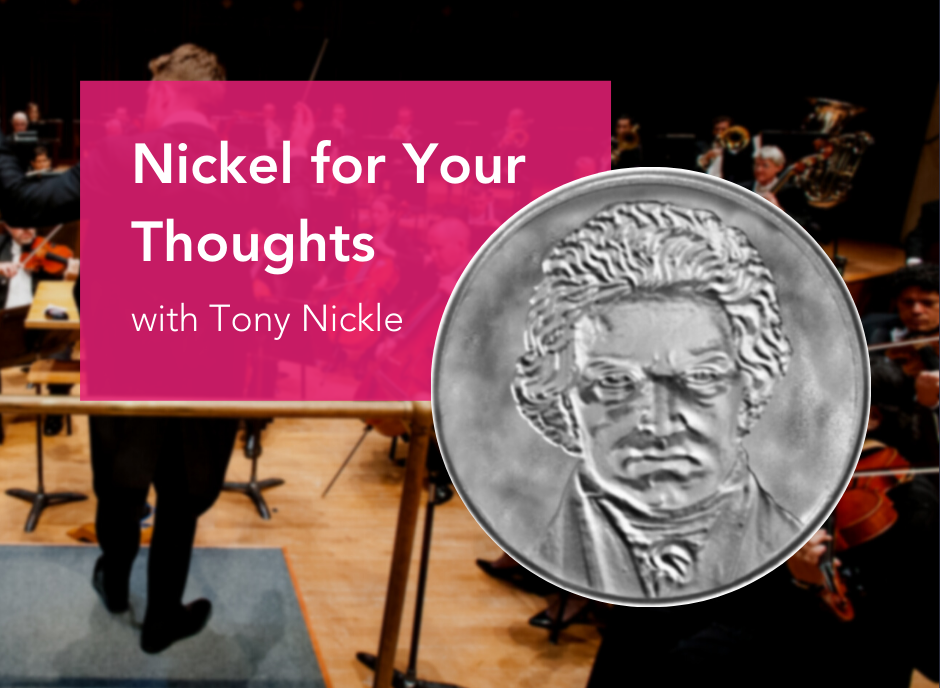In his own words, Artistic Administrator Tony Nickle shares what he believes to be the high points of the program, but with a little edge and humor for good measure.
Two weeks ago we performed an interesting journey through the American sound with Dvořàk’s New World Symphony and Jessie Montgomery’s Banner. This week we take on what are arguably the bookends of German Romanticism in the symphonic rep: a rogue C-sharp in the opening phrase of Beethoven’s Eroica Symphony, and Richard Strauss’s reflection on the genre’s twilight near the end of World War II. At its core, Romanticism is a focus on dramatic elements in the art that bring front and center the artist’s perspective on that drama. Is it hyperbole to tie the beginning of one of music history’s most profound periods to a single note? Probably… definitely. But, few moments around the beginning of the Romantic Era shine so brightly with devices that are clearly outside of the Classical aesthetic. So, let’s talk about that C-sharp:
Haydn almost single handedly codified the rules of how to write a symphony, especially in relation to the building blocks and how they relate to create a complete structure, and structure was of paramount importance to the Classical aesthetic. Think of architecture around America from around the late 1700s – the U.S. Capitol Building, Monticello, the University of Virginia campus (a little later, but not much) – symmetry and structure reign. Haydn, Mozart, and early Beethoven all frequently played with these rules, but it was typically more with intent to surprise or play against expectation, and not particularly to inspire deeper meaning for the audience. But, this C-sharp is altogether a different kind of surprise. The symphony begins in E-flat major with two declamatory chords followed by the opening theme; Haydn, Mozart and even the first several years of Beethoven taught audiences that we’ll stay in E-flat until the entire first idea had been stated. However, only halfway through this very first phrase Beethoven moves the melody down by half steps to a C-sharp (and really leans into it), which has no place in the key of E-flat major. This maverick note is no wink-and-a-nod like the witty Haydn and Mozart sometimes created through unexpected turns, but rather an intentionally created problem that Beethoven spends the first movement working through. While he does work through this problem with many Classical devices (e.g. moving the petulant theme through several different keys in the development), it’s done so with a focus on the struggle to get through, and on a much larger scale than anything written before to boot. Then, when Beethoven finally arrives at the recapitulation we expect a traditional restating of the original theme in the original key, but instead he presents the theme only with diatonic notes – meaning they all belong in the key of E-flat major. After everything we’ve been through, this iteration of the theme sounds so triumphant over the problem that Beethoven presented at the very beginning. You could almost call it heroic, which he actually did in the symphony’s subtitle. So while Beethoven uses many Classical technical devices in the piece, they are subservient to a dramatic statement, making this one of the earliest developed examples of Romanticism in music.
I won’t dive too much into Richard Strauss’ Metamorphosen except to say that by the time World War II is drawing to a close, Strauss the Romantic is already stylistically a relic in many ways: Wagner and Mahler have been gone for decades, Schoenberg has moved from late Romanticism into atonality, and Stravinsky has thoroughly shaken the foundations of 20th-century music and lead the charge for Modernism. Not only that, but Strauss was witnessing the final days of the Third Reich. By all accounts, everything about the world he knew was falling away, and the work almost sounds like an elegy to the end of German Romanticism. It’s a stunning piece with 23 string instruments, each on their own part.
I hope to see you Friday or Saturday night in Jacoby Symphony Hall for this deeply moving program.
By Tony Nickle, Artistic Administrator


